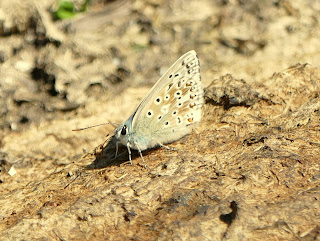It was a glorious July day when six of us set off across Amberley Wild Brooks to see what we could find. Only three damselfly and dragonfly species were photographed but the many other plants and creatures seen more than compensated. And that is the joy of being with a group of naturalists -- one sees more than one would alone.
Here William Coleman has identified a Melilotus species possibly M. officinalis
Click on any picture to enlarge it.
The ditches were lined with Meadowsweet, Filipendula ulmaria.
A hoverfly, possibly Microdon mutabilis was on this flower. If so, its larvae live in ants nests preying on the eggs and larvae of a various ant species, often, but not exclusively, in wet or boggy situations.
 |
| Goldfinches flying around |
 |
| Marsh Woundwort |
 |
| Meadow Brown |
 |
| Meadow Brown |
Wild Parsnip, which is
poisonous: the sap causes blisters with sunlight.
 |
| Tansy, Tanacetum vulgare |
 |
| Wild pea |
 |
| Gatekeeper |
A Woundwort, but which one?
Ah yes! Marsh Woundwort,
Stachys palustris. That fits as we are on the edge of Amberley swamp.
Hundreds of tiny flies were swarming around this puddle.
I have seen them on my garden pond: the males flashing their wings to attract a female.
Grasshopper and Crickets
There were hundreds of tiny grasshoppers that I did not photograph. Here are a few of the bigger ones.
This fine insect is a Short-winged Cone-head -
Conocephalus dorsalis, a female with large ovipositor.
Common in southern England, it likes wet meadows lowland peatland and reed beds. Amberley Levels then.
 |
| Short-winged Cone-head - Conocephalus dorsalis |
This is quite different: Roesel's Bush-cricket,
Metrioptera roeselii is a European bush-cricket, named after August Johann Rösel von Rosenhof, a German entomologist. Source;
https://en.wikipedia.org/wiki/Roesel%27s_bush-cricket
Above is a male with short wings.
Whereas this one has large wings and is much rarer.
 |
| Meadow grasshopper, Chorthippus parallelus |
Smaller and with short antennae, this is a Meadow grasshopper,
Chorthippus parallelus
Dragonflies and Damselflies
 |
| Four-spotted Chaser, Libellula quadrimaculata |
We saw few flying or resting.
Four-spotted Chaser, Libellula quadrimaculata
Azure damselflies mating,
Coenagrion puella
See
http://www.peterlovetttalks.co.uk/product02.html if interested in a talk on these amazing insects.
 |
| Broad-bodied Chaser, male, Libellula depressa |
 |
| Small Skipper |
 |
| White Water-lily, Nymphaea alba |
 |
| White Water-lily, Nymphaea alba |
 |
| Deer |
 |
| Mugwort, Artemisia vulgaris |
 |
| Nipplewort, Lapsana communis |
Nipplewort,
Lapsana communis a member od the Daisey family.
 |
| Nipplewort, Lapsana communis |
The following clip is very poor quality and is shown only because the Black-headed gulls were flying across the meadows swerving presumably to catch insects. Something that I had not observed before.
At an overall pace of one mile per hour these nature walks are likely to frustrate anyone looking for a straight walk at 3mph+. It was lovely though to take time to just stop, stare and enjoy our wildlife with relaxed company. Thanks to you all who came yesterday.
My next nature walk, linear 3.6 miles,
"In search of Broad-leaved Helleborines" may be next week if the weather looks fine, from East Dean car park. The route is; bus to Exceat. Friston Forest, Friston Place, Friston Church*, East Dean, Hikers Rest Cafe. The route involves frequent quite steep elevations and descents. And the time depends entirely on what is flowering and flying.
Or, I might just go somewhere for butterflies and "The Pride of Sussex"
*(twenty minutes or so at the pond -- see
https://sussexrambler.blogspot.com/2016/07/a-very-fine-sussex-walk-part-one_27.html and
https://sussexrambler.blogspot.com/2016/07/a-very-fine-sussex-walk-part-two.html)















































































